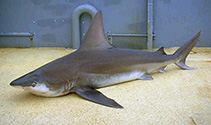| Family: |
Carcharhinidae (Requiem sharks) |
| Max. size: |
300 cm TL (male/unsexed); max.weight: 118 kg; max. reported age: 34 years |
| Environment: |
benthopelagic; brackish; marine; depth range 0 - 500 m, oceanodromous |
| Distribution: |
Widespread in tropical and warm-temperate waters worldwide. |
| Diagnosis: |
Dorsal spines (total): 0-0; Dorsal soft rays (total): 0-0; Anal spines: 0-0; Anal soft rays: 0-0. A stout shark with a moderately long, rounded snout, high, triangular, saw-edged upper teeth, and an interdorsal ridge; 1st dorsal fin very large and erect (Ref. 5578). Grey-brown or bronzy with no prominent markings, white below (Ref. 5578). Fins plain or with slightly dusky tips (Ref. 5485). |
| Biology: |
Found inshore and offshore, on continental and insular shelves and adjacent deep water (Ref. 244). Common at bays, river mouths and in harbors; avoids sandy beaches and the surf zone, coral reefs and rough bottom, and surface waters (Ref. 244). Coastal-pelagic, but usually bottom associated at 1-280 m (Ref. 58302). Sometimes in oceanic waters (Ref. 9997). Known to make extended seasonal migrations in some parts of its range (Ref. 6871). Feeds mainly on bony fishes, also small sharks, cephalopods, and shrimps (Ref. 5578), rays and gastropods (Ref. 5213). Youngs feed heavily on crustaceans such as blue crabd and mantis shrimp (Ref. 93252). Viviparous (Ref. 50449). Sexual dimorphism is evident in thickness of skin layer of maturing and adult females (Ref. 49562). Females live as long as 21 year; males 15 years (Ref. 27549). Populations are segregated by age. Young readily kept in aquaria (Ref. 244). Utilized for human consumption, for leather and oil (Ref. 244). Marketed fresh, smoked, dried-salted and frozen; fins are valued for soup (Ref. 9987). Used in Chinese medicine (Ref. 12166). Records to 300 cm TL uncertain (Ref. 9997). TL to 300 cm (Ref. 26938). Angling: an inshore fish and a good light-tackle fighter (Ref. 84357). |
| IUCN Red List Status: |
Endangered (EN); Date assessed: 03 December 2020 (A2bd) Ref. (130435)
|
| Threat to humans: |
harmless |
Source and more info: www.fishbase.org. For personal, classroom, and other internal use only. Not for publication.
